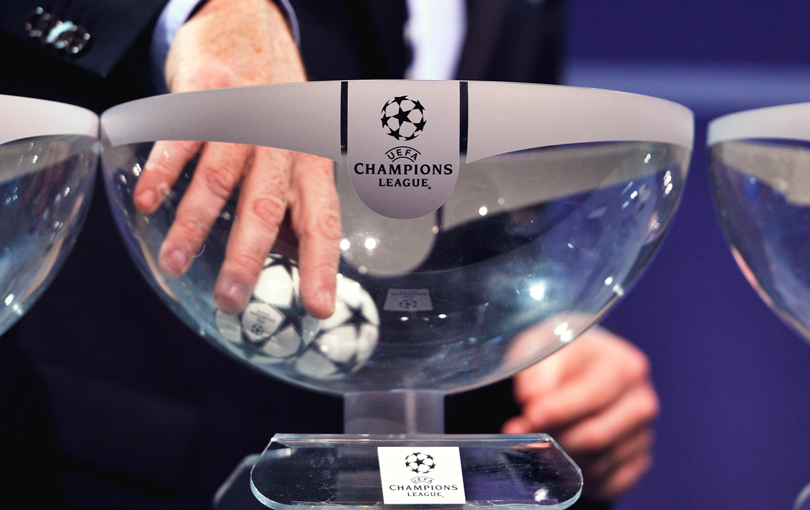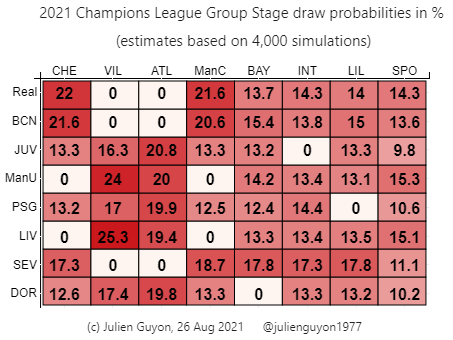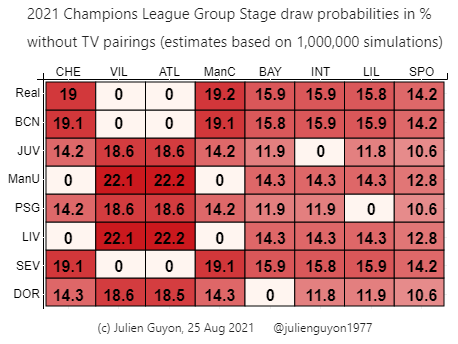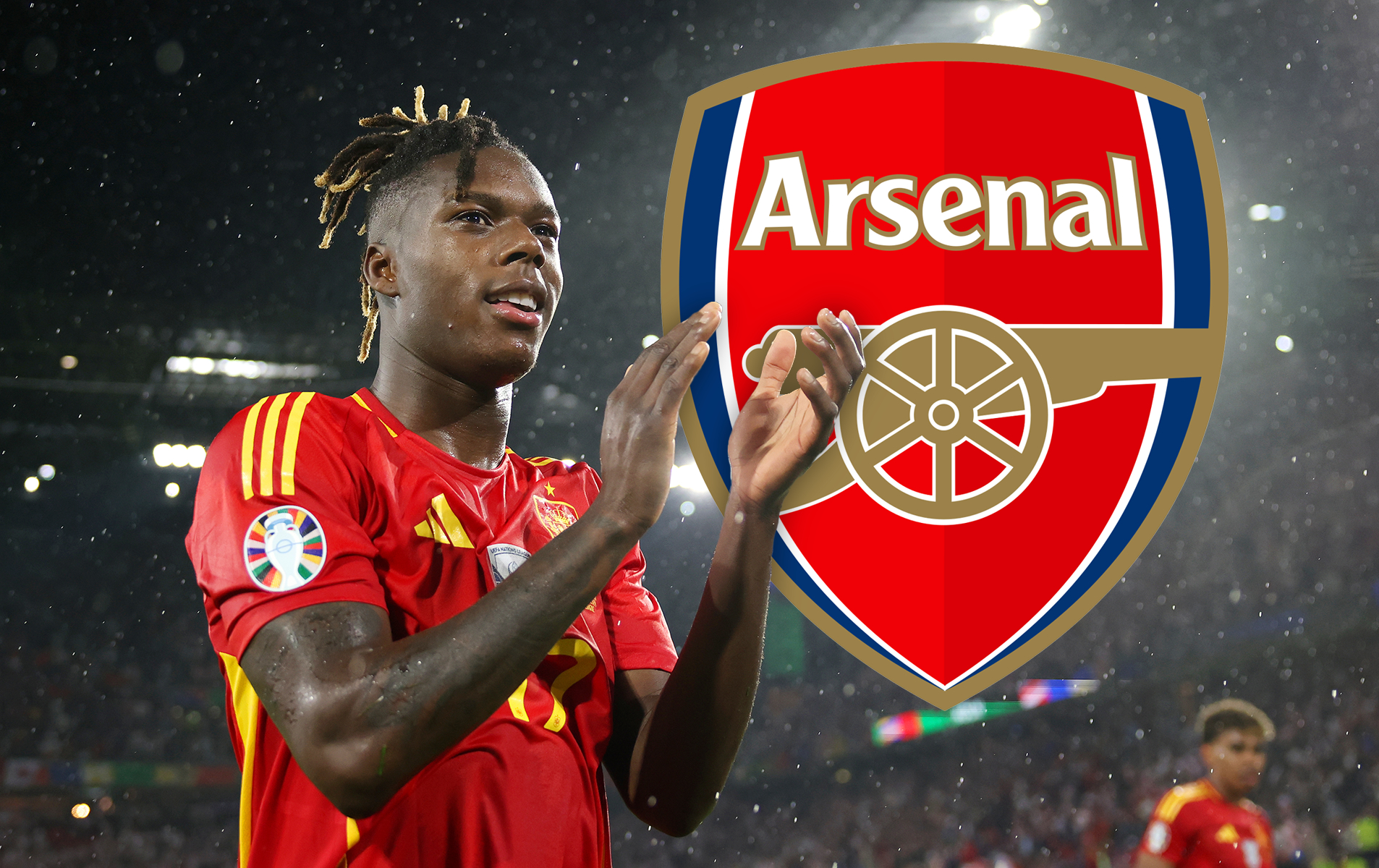Champions League group stage draw: who are the most likely opponents of Manchester City, Manchester United, Liverpool and Chelsea?
Julien Guyon presents a guide of how the Champions League draw works - and who your team are likely to face

The European football season really kicks off today with the draw of the Champions League group stage, with four English teams - that's Chelsea, Manchester City, Liverpool and Manchester United - involved in this season's competition.
As usual, the eight groups of four teams each will be drawn from four pots of eight teams; each group is made of one team randomly drawn from each pot. Since 2015, UEFA seeds the domestic champions of the highest-ranked leagues in Pot 1 together with last year's winners. Since 2018, the Europa League winner has also gained direct access to Pot 1. The following pots are built differently: they follow the UEFA club coefficient, with the best teams in pot 2 and the weakest teams in Pot 4.
All English teams are in Pots 1 and 2. Premier League champions Manchester City are in Pot 1 together with the titleholders Chelsea, while Manchester United and Liverpool have been seeded in Pot 2.

The groups will not be formed completely at random. One UEFA rule which is well known to many football fans is that two teams from the same country cannot be drawn into the same group. This greatly impacts the draw probabilities. For instance, Manchester United and Liverpool can only be drawn against six teams from Pot 1: Villarreal, Atletico, Bayern Munich, Inter Milan, Lille and Sporting Lisbon.
As a consequence, Sporting, even though it can play against all Pot 2 teams, will have an almost 1/6 chance of facing United and Liverpool - but only around a 7% chance of facing Juventus. One could think that United and Liverpool have exactly a probability of 1/6 of being drawn against each of its six possible Pot 1 opponents. This would indeed be the case if the draw started with randomly picking one of those six teams. However, this is not how the draw works.
Let us focus for instance on the likelihood of United-Sporting. Of course, it cannot be at the same time 1/6 (from the Red Devils having only six possible Pot 1 opponents) and 1/8 (from Sporting having eight possible Pot 2 opponents). One could list all the admissible outcomes for Pots 1 and 2, and estimate the likelihood of Man United-Sporting by the proportion of admissible outcomes where the Red Devils face the Portuguese. However, this would not yield the correct probabilities either, because this is not how the draw works either.

In fact, Pot 1 teams are first placed randomly in groups A to H. Then Pot 2 is emptied, and each time a team is drawn from Pot 2 a computer lists the admissible groups for that team (This is not as simple as it looks, as it requires checking for possible dead-ends). One such group is then randomly drawn.
For instance, if Manchester United is drawn first from Pot 2, it will have a 1/6 chance of facing each of its six possible Pot 1 opponents. However, if they are drawn after Real Madrid, Barcelona and Sevilla, say, United will have much fewer options, and Sporting's group will likely not be available anymore for them since all Pot 2 teams may have ended there--and the three Spanish teams cannot face Atletico and Villarreal. This naturally decreases the chances that the Reds face the Portuguese.
Another less known rule complicates the computation even more. Uefa uses TV pairings so as to maximize TV viewing. Paired teams from the same country, say Real Madrid and Barcelona, are allocated to two different halves of the groups (groups ABCD vs groups EFGH), so that if one team plays on Tuesday, the other team plays on Wednesday. For England, Liverpool is paired with Manchester United, and City is paired with Chelsea.
Get FourFourTwo Newsletter
The best features, fun and footballing quizzes, straight to your inbox every week.
In particular, this means that during the draw, if Liverpool is placed in groups ABCD, United fans will already know that the Red Devils can only be drawn in groups EFGH. For Italy, Juventus is paired with Inter Milan and AC Milan with Atalanta; for Spain, the pairings are Real-Barca and Atletico-Sevilla.
TV pairings make the probability calculations even more complex. They have a complicated impact on the draw probabilities, which is often underestimated.
In order to estimate the correct draw probabilities, we have simulated 4,000 draws following exactly the UEFA procedure. The most likely matchups are Manchester United vs Villarreal and Liverpool vs Villarreal (around 24% each); the least likely ones are Sporting vs Juventus and Sporting vs Dortmund (around 10%). The most likely opponents of Manchester City and Chelsea are Real Madrid and Barcelona (around 21% each); the Citizens and the Blues only have about a 13% chance of facing Juventus, PSG or Dortmund.
The small fluctuations that you observe in the probability table are only due to the so-called sampling error - the fact that we only simulate a finite number of draws. In particular, as regards draw probabilities, Chelsea and Manchester City are perfectly interchangeable, so in fact, they share the exact same probabilities. The same is true of Manchester United and Liverpool. Sevilla is not perfectly interchangeable with Real and Barcelona because of the TV pairings - this is why Barcelona and Real Madrid are slightly more likely opponents than Sevilla for Chelsea and City, for instance.

In order to measure the impact of TV pairings on the draw probabilities, we have also performed simulations that ignore them. TV pairings have a sizeable impact. While they increase Man City's and Chelsea's probability of meeting Villarreal by about 2 to 3 percentage points, they decrease the probability of a Bayern-Real matchup by about 2 percentage points.
It is remarkable that a seemingly harmless rule that is only concerned with scheduling has so much impact on the competition - but that's the nature of such a complicated draw procedure...
Julien Guyon is a French mathematician and football fan. He is a quantitative analyst, and adjunct professor in the Department of Mathematics at Columbia University and at the Courant Institute of Mathematical Sciences, New York University. He has written several articles on mathematics and football for The New York Times, The Times and Le Monde. More probability tables are available on the author’s Twitter account (@julienguyon1977) and website: http://cermics.enpc.fr/~guyon/
Subscribe to FourFourTwo today! Guarantee the finest football stories and interviews dropping on your doorstep first every month.
NOW READ
LIST 12 of the most shocking player vs fan punch-ups
FANTASY PREMIER LEAGUE FourFourTwo writers reveal their FPL teams
ARSENAL It's not the defeats that are worrying for Arsenal – it's the total lack of creativity
